

Appels gratuits sur Internet et appels téléphoniques économiques. Skype 7 Things. Skype. Android. Mobiles in-a-Box. Catégorie:Sciences de l'information et de la communication. 3G and 4G LTE Cell Coverage Map - OpenSignal. Category:Digital technology. Open Hardware. When Raspberry Pi Isn't Enough: Behold the Open Source Laptop. Raspberry Pi made waves in recent years as a computer that you can buy for just $35.
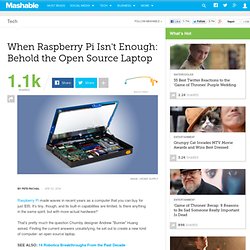
It's tiny, though, and its built-in capabilities are limited. Is there anything in the same spirit, but with more actual hardware? That's pretty much the question Chumby designer Andrew "Bunnie" Huang asked. Finding the current answers unsatisfying, he set out to create a new kind of computer: an open source laptop. Kano - Make a Computer. Technologies de l'information et de la communication.
Un article de Wikipédia, l'encyclopédie libre.
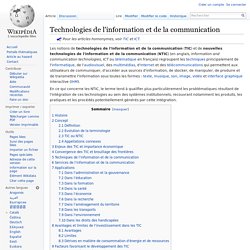
Pour les articles homonymes, voir TIC et ICT. En ce qui concerne les NTIC, le terme tend à qualifier plus particulièrement les problématiques résultant de l'intégration de ces technologies au sein des systèmes institutionnels, recouvrant notamment les produits, les pratiques et les procédés potentiellement générés par cette intégration.
Histoire[modifier | modifier le code] Après les premiers pas vers une société de l'information qu'ont été l'écriture puis l'imprimerie, de grandes étapes ont été le télégraphe électrique, puis le téléphone et la radiotéléphonie. L'informatique a pris son essor grâce aux circuits imprimés les constructeurs d'informatique décentralisée innovant rapidement. Avec le développement d'Internet et du WEB 2.0, les usages des TIC se sont développés et la grande majorité des citoyens des pays industrialisés utilise ces outils pour accéder à l'information. Concept[modifier | modifier le code] Dossier médical personnel. Category:Information technology.
Portal:Information technology. The Computing and Information Technology Portal Ethernet /ˈiːθərnɛt/ is a family of computer networking technologies for local area networks (LANs).
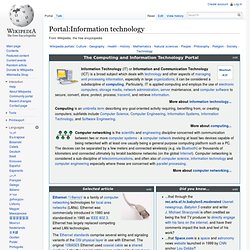
Ethernet was commercially introduced in 1980 and standardized in 1985 as IEEE 802.3. Ethernet has largely replaced competing wired LAN technologies. The Ethernet standards comprise several wiring and signaling variants of the OSI physical layer in use with Ethernet. The original 10BASE5 Ethernet used coaxial cable as a shared medium.
AZoSensors - The A to Z of Sensors and Sensing Technology. Thin client. An Aleutia E3 thin client, with flash memory A thin client (sometimes also called a lean, zero or slim client) is a computer or a computer program that depends heavily on some other computer (its server) to fulfill its computational roles.

This is different from the traditional fat client, which is a computer designed to take on these roles by itself. The specific roles assumed by the server may vary, from providing data persistence (for example, for diskless nodes) to actual information processing on the client's behalf. Thin clients occur as components of a broader computer infrastructure, where many clients share their computations with the same server. As such, thin client infrastructures can be viewed as providing some computing service via several user interfaces. Thin-client computing is also a way of easily maintaining computational services at a reduced total cost of ownership.[1] History[edit] A connected Samsung Chromebox as seen from above.
The term stuck for several reasons. Thinstation - a light, full-featured Linux thin client OS. Thinstation is a basic and small, yet very powerful, Open Source thin client operating system supporting all major connectivity protocols: Citrix ICA, NoMachine NX, 2X ThinClient, Microsoft Windows terminal services (RDP, via RDesktop), VMWare Horizon View, Cendio ThinLinc, Tarantella, X, telnet, tn5250, VMS terminal and SSH (No special configuration of the application servers is needed to use Thinstation).
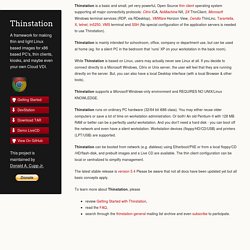
Thinstation is mainly intended for schoolroom, office, company or department use, but can be used at home (eg. for a silent PC in the bedroom that 'runs' XP on your workstation in the back room). While Thinstation is based on Linux, users may actually never see Linux at all. If you decide to connect directly to a Microsoft Windows, Citrix or Unix server, the user will feel that they are running directly on the server. Databases & Linked Data. Achat/vente High-Tech : informatique, tablettes, smartphones, TV, multimédia. ICT Development Index. The ICT Development Index (IDI) is an index published by the United Nations International Telecommunication Union based on internationally agreed information and communication technologies (ICT) indicators.
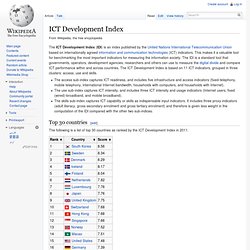
This makes it a valuable tool for benchmarking the most important indicators for measuring the information society. The IDI is a standard tool that governments, operators, development agencies, researchers and others can use to measure the digital divide and compare ICT performance within and across countries. The ICT Development Index is based on 11 ICT indicators, grouped in three clusters: access, use and skills. Top 30 countries[edit] The following is a list of top 30 countries as ranked by the ICT Development Index in 2011. References[edit] Information and communications technology. Information and communications technology (ICT) is often used as an extended synonym for information technology (IT), but is a more specific term that stresses the role of unified communications[1] and the integration of telecommunications (telephone lines and wireless signals), computers as well as necessary enterprise software, middleware, storage, and audio-visual systems, which enable users to access, store, transmit, and manipulate information.[2] The term Infocommunications is sometimes used interchangeably with ICT.
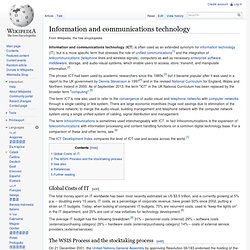
In fact Infocommunications is the expansion of telecommunications with information processing and content handling functions on a common digital technology base. For a comparison of these and other terms, see.[6] The ICT Development Index compares the level of ICT use and access across the world.[7]
Secure, Centrally Managed Computers.